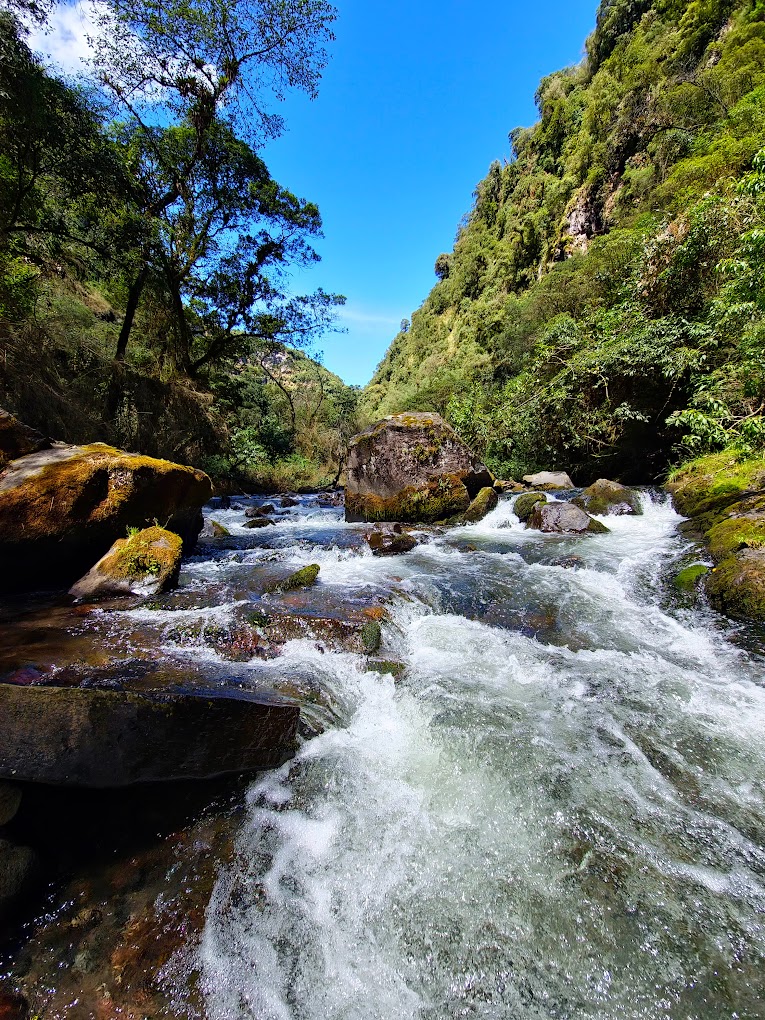Nestled within the inter-Andean valley, the Pasochoa refuge safeguards a unique forest that has been protected from destruction due to its difficult access inside the caldera. This refuge is an ideal destination for both adventure seekers and those looking for a peaceful walk to admire the Andean biodiversity. With a rocky volcano to climb and well-signposted paths to explore, visitors can spend a night at the camping site and soak in the natural beauty.
Pasochoa o 4,200 mts Volcano
The Pasochoa Volcano is an extinct volcano, partially isolated in the inter-Andean valley. It is practically in the middle of the Machachi valley, surrounded by extensive agricultural and livestock fields. Due to its location in a populated area, it is visible from various sites. One of its peculiarities is its collapsed caldera, covered by dense forest, visible from the west. From the eastern slope, one can observe its steep cliffs.
The dormant volcano’s caldera measures 2 kilometres in diameter and opens to the west. Its semicircular shape houses the Andean forest that is protected by the refuge between the Santa Ana and Sambache ravines. The water flowing from these heights forms the San Pedro River, which is a tributary of the Guayllabamba.
Characteristics of Andean Cloud Forests
The Andean forest in the Pasochoa refuge is located between the páramos and the agricultural and urban areas of the lower parts. These forests are characterised by mist, which covers them for several hours a day. This results in them maintaining an extraordinary humidity, although it doesn’t always rain. The cloud forests have a complex structure with several levels, in which the abundance of epiphytes stands out.
Trails for Exploring the Biodiversity of the Andean Forest
The Environmental Education Centre, the camping and picnic area, and administrative offices are located at the entrance of the refuge. There are six trails available for visitors to explore the refuge’s biodiversity, ranging from a self-guided 900-metre Hummingbird trail to an advanced difficulty 8-kilometre Wax Palm trail.
The Environmental Education Centre offers visitors the opportunity to learn about the flora and fauna of the Andean forest. Visitors can also explore the Friend Nature trail, a self-guided 1-kilometre walk through the misty forest, which is of medium difficulty. The Forest for All trail is a 2-kilometre, medium-difficulty route crossing the cloud forest. It starts from the Hummingbird trail and ends at the Amiga Naturaleza trail.
Those looking for a more challenging trek might consider the Mayguayacu trail. This is a medium-difficulty route of 3.5 kilometres that begins in the misty forest and reaches the evergreen forest. The Wax Palm trail is an 8-kilometre, advanced-difficulty trek from the Mayguayacu trail to the Los Pantyhose trail. Finally, the Pantyhose trail passes through the moor and the forest of Polylepis and reaches the summit of Pasochoa. This trail is of advanced difficulty and requires a guide to accompany the group.
History and Administration of the Pasochoa Protected Forest
The Andean forest of the caldera is the last remnant of the ancient forest of the zone of Uyumbicho. It was described by the Spanish conquerors as “a sea of trees stretched between the Tiopullo knot, the leaks of the old southern ejido of Quito (Guajaló) and the proximity of the towns of Cumbayá and Tumbaco”. However, by the 17th century, most of the forests had disappeared, as the wood of trees like the myrtle, quishuar, cedar, walnut, and sisín, among others, was used to build and heat the homes of Quito.
In the early 20th century, the haciendas surrounding the Pasochoa caldera, which had belonged to religious communities, were acquired by the State and entrusted to the Ministry of Health for administration. The declaration of Pasochoa as a protected area was initiated by the Ecuadorian scientist Fernando Ortiz Crespo, who proposed its designation as a “Protected Forest” to the State Portfolio in 1982. The area was then administered by Fundación Natura, a private conservation organisation, for almost two decades.
Flora and Fauna of the Pasochoa Protected Forest
The Pasochoa Protected Forest offers a glimpse of the remarkable biodiversity that thrives in the region. A walk through the forest reveals various species of orchids, huaycundos, umbrellas, as well as alders, pumamaquis, myrtles and cedrillos. Palms of bouquets and shrubs such as little shoes, colcas, and chilcas, also prevail. Moreover, the forest is a source of medicinal and food plants, including horse sucks, nettle, plantain, yerba mora, and tocte. In the upper part of the forest lies the páramo of pajonal mixed with small bushes of romerillo and mortiño.
The Pasochoa Protected Forest is home to a range of wildlife, including large mammals like pumas, white-tailed deer and páramo wolves. Smaller mammals, such as marsupial mice and opossums, rabbits, and Andean weasels or chucuris, also inhabit the area. The forest is an excellent spot to view birds, particularly hummingbirds such as the sword-billed, bright sunbeam, and long-tailed puffin. Other bird species that visitors can observe include quilicos, curiquingues, Andean guans, turtle doves, woodpeckers, huiracchuros, red-crested cotingas, and tanagers. Amphibians such as little glass frogs and marsupial frogs also thrive in the forest, with some crouching in the branches of trees, and others preferring to live inside bromeliads.
In conclusion, the Pasochoa Protected Forest is a vital conservation area that provides a glimpse into the rich biodiversity of the Uyumbicho zone. Its unique and valuable ecosystem should be protected and preserved for future generations to come.
Want to join this Adventure?





